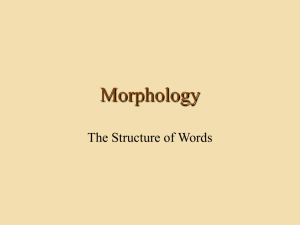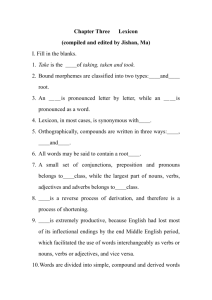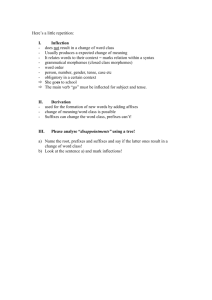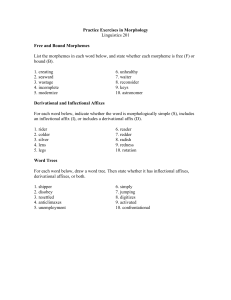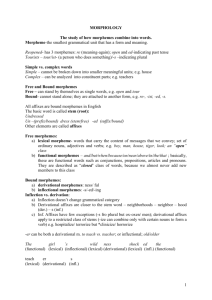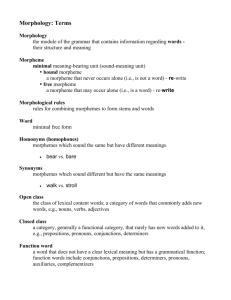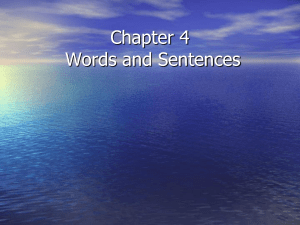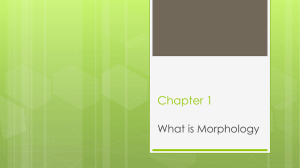Morphology Powerpoint
advertisement
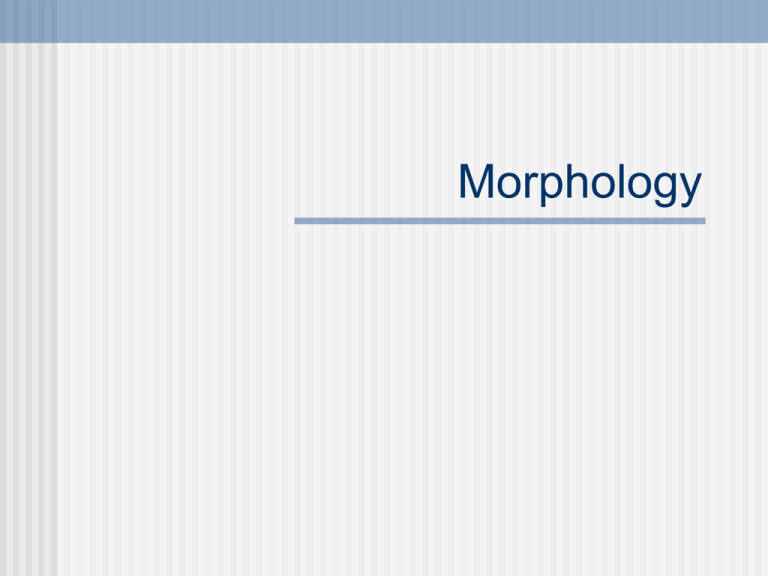
Morphology Overview We all have an internal mental dictionary called a lexicon Morphology is the study of words (the study of our lexicon) To look at morphology, we must consider both form and meaning Affixes Affixes are parts of words that “affixed” to other parts of words We have prefixes, suffixes, and infixes Prefix goes at the beginning (pre-) Suffix goes at the end (-ing) Infix goes in the middle (-en-) Derivation vs. Inflection Inflection is the creation of different grammatical forms of all words. cat -> cats In English, inflectional affixes are always suffixes P. 151 gives a chart of inflectional affixes Derivation is the process of creating words out of other words. cat -> catty Cat is the root on which catty is built. The form of the root is the stem. The added pieces are affixes. Morphemes The parts that words are made of are called morphemes. A stem may contain more than one morpheme “Cattiness” Root= cat Stem = catty (contains two morphemes= root and one affix) Second affix = “ness” Free morpheme-- can be used as words by themselves Bound morpheme-- morphemes that cannot stand alone (such as affixes) Bound root-- root word that cannot stand alone (transfer, infer, confer, defer, prefer, etc.) Content morpheme-- morpheme with identifiable meaning or something that indicates a change in meaning Function morpheme-- serve a “function” in the sentence but not necessarily with an identifiable meaning Practice P. 176 #2 Recap: Derivational vs. Inflectional Morphological Processes (Ways to Make Words) Affixation (making new words by adding affixes to stems) Compounding (making new words from two or more independent words) Reduplication (making new words by doubling an entire free morpheme or part of it) Alternations (making new words by morphemeinternal modifications) Suppletion (making new words that are phonetically unrelated to the shape of the root) Affixation making new words by adding affixes (prefix, suffix, infix) to stems Tagalog example of an infix Verb stem sulat ‘write’ bili ‘buy’ kuha ‘take’ Infinitive sumulat ‘to write’ bumili ‘to buy’ kumuha ‘to take’ Compounding making new words from two or more independent words English: girlfriend, blackboard, airconditioner, life-insurance salesman German: Wunderkind ‘child prodigy’, muttersprache ‘native language’ Reduplication making new words by doubling an entire free morpheme or part of it English: Do you like him as a friend or do you like-like him? Indonesian: rumah ‘house’ vs. rumahrumah ‘houses’ Tagalog: bili ‘buy’ vs. bibili ‘will buy’ Alternation • making new words by morpheme-internal modifications English: ring, rang, rung, man vs. men strife vs. strive Suppletion • Making new words that are phonetically unrelated to the shape of the root • We often think of these as being irregular English: • is vs. was • go vs. went Morphological Types of Languages Analytic Made up of sequences of free morphemes Each word consists of a single morpheme with no affixation Example: Mandarin Chinese (p. 163) Synthetic Made up of bound morphemes attached to other morphemes Involves affixation Example: Hungarian (p. 164) Three types of synthetic languages: agglutinating, fusional, and polysynthetic Agglutinating Languages Fusional Languages Polysynthetic Languages
